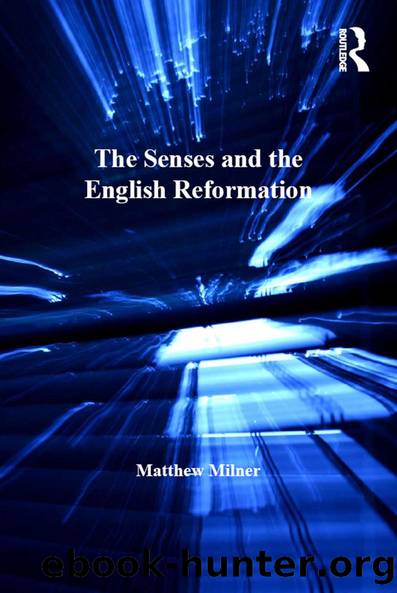The Senses and the English Reformation by Matthew Milner

Author:Matthew Milner [Milner, Matthew]
Language: eng
Format: epub
Tags: History, Europe, Great Britain, General
ISBN: 9781317016366
Google: VzCrCwAAQBAJ
Publisher: Routledge
Published: 2016-03-03T16:12:44+00:00
CHAPTER 6
Perception, Polity and Gostly Thynges in Reformation England
The evangelical emphasis on empiricism and the persistence of affective sensory physiology resulted in two underlying issues for Tudor religion from the 1530s. Unlatching English religious life from the institutional churchâs modes of authentication required restructuring how individual perceptions of religious life related to one another. It was not enough simply to discern true and false religion. It also meant knowing whose senses were best able to do so. This brought about a fuller articulation of sensory hierarchies within English society and the close connections between political power and perception. Perceptive hierarchies in Tudor England were closely related to Tudor polity, foremost the keystone to Tudor religious policy â the Royal Supremacy. Examining the language surrounding Tudor monarchy, morality and religious reform exposes the extent to which reform efforts contained within them a sensory strand which gave pride of place to royal perception. Likewise, though reformers were quick to find fault with pre-reformation religious life, it was much more difficult to resolve what kinds of effects godly religious experiences might have on churchgoers on account of affective sensory physiology. This displaced, but increasingly historiographically important, topic is pervasive. There was wide agreement that it was necessary to get rid of false religion, but it took until the end of the sixteenth century for the conflict between evangelical doctrine and affective sensation to become fully manifest in England. The maintenance of affective sensory physiology meant religious sensing still did something to churchgoers; the real problem was to define it. How reformed religiosity accounted for sensory experiences and their work on English eyes, ears, hands, tongues and noses was not at all clear when it came to the things of godly religion. These two problems permeated English religious life from the 1530s onwards. They form critical backdrops to the processes of reform and religious life throughout the early-modern period in England.
Download
This site does not store any files on its server. We only index and link to content provided by other sites. Please contact the content providers to delete copyright contents if any and email us, we'll remove relevant links or contents immediately.
Never by Ken Follett(2865)
The Man Who Died Twice by Richard Osman(2287)
Machine Learning at Scale with H2O by Gregory Keys | David Whiting(2252)
Fairy Tale by Stephen King(2056)
Will by Will Smith(2023)
Reminders of Him: A Novel by Colleen Hoover(1866)
Rationality by Steven Pinker(1757)
The Stranger in the Lifeboat by Mitch Albom(1522)
The Becoming by Nora Roberts(1320)
Friends, Lovers, and the Big Terrible Thing by Matthew Perry(1315)
A Short History of War by Jeremy Black(1294)
New Morning Mercies: A Daily Gospel Devotional by Paul David Tripp(1292)
HBR's 10 Must Reads 2022 by Harvard Business Review(1250)
The Strength In Our Scars by Bianca Sparacino(1232)
The Fall of Babel by Josiah Bancroft(1229)
Can't Hurt Me: Master Your Mind and Defy the Odds - Clean Edition by David Goggins(1215)
515945210 by Unknown(1205)
Fear No Evil by James Patterson(1101)
Love on the Brain by Ali Hazelwood(1082)
